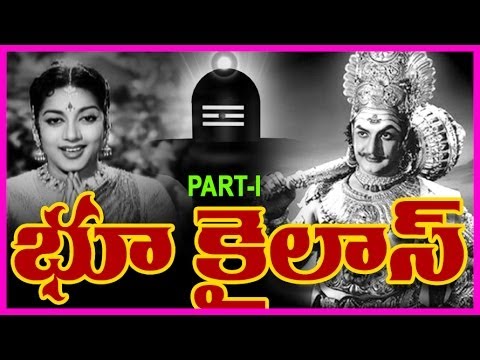One of the great golden age films of Telugu cinema is the silver screen saga Bhookailas. Yet another classic churned out by the original Super Star of Andhra, NTR, it is a timeless tale for all ages, and even, all philosophies. A little known fact is that this 1958 movie was actually preceded by a 1940 production, that had a national integration streak. It was nevertheless remade post-Independence, with results for the ages.
Story
Say the name Ravana and instantly a ferocious rakshasa with ten heads and a penchant for wrong doing sprouts in our minds. And yet, this descendant of Maharishi Pulastya was a legendary bhakta of Lord Shiva, and engaged in great tapasya (austerities) to win his favour. Indeed, there was a Ravana before the Ramayana, and one of the greatest celluloid showcases of his more sympathetic side comes to us from the film Bhookailas.
In effect, it is an origin story. No, not so much of the rise and corrupting of Ravana, but of the installation (Murthi Sthapana) of Lord Shiva’s atmalinga at Gokarna, in Coastal Karnataka. This place is known as Dakshina Kashi and “Bhookailasa” (where the Earth meets the Divine Kailasa), giving us the eponymous film title (in fact, the Ramachandrapur Math and the Mahabhaleshwar Temple function there to this day). The story, therefore, centers around the fear Indra has of Ravanasura’s rising power, and how the tapasya of both Ravana and his devout mother Kaikesi is disturbed. The reason for this is tapasya and bhakti, especially by one’s womenfolk (mother or wife), are considered to be the source of a man’s power. It is Narada who alerts Indra to this reality, and urges him to save his throne in Amaravati, capital of Devaloka.
Production
Although N.T. Rama Rao is undoubtedly the hero and lead of the cinema, as Ravana, Akkineni Nageshwara Rao very often steals the show as Narada (though NTR steals it back with some riveting scenes). His levity and mischief is masterfully manifested and serves as wondrous foil to the former’s severity and piety. Indeed, we see the great Muni play the role of divine instigator, first taking the side of Indra and the Devas and then later feeling sympathy for Ravana, who humorously calls him “Thatha“, or grandfather. This ancient kinship is the source of much humor in the production.
S.V.Ranga Rao serves as an excellent antipode in the form of Mayasura, the ruler of the Netherworld. The central friction in the story revolves around Ravana’s touting of Lord Shiva as supreme and his personal hatred for Vishnu. Indeed, the Saivism of Ravana and the Vaishnavism of Narada are charmingly dealt with in song as well. Nevertheless, the ultimate reconciliation and fundamental unity of Hari-Hara are shown in how Vishnu and Shiva work in unison. Indeed, like Sanskrit and Tamil, they are but two sides of the same coin.
Nevertheless, this schism becomes a near cataclysm when Mayasura takes umbrage at Ravana’s disrespect to Vishnu. What follows is a wise and excellent speech by Narada muni, that assorted fundamentalists, casteists, regionalists and selfish people of all shades would do well to listen and digest.
Of course, it is the love story of Ravana and Mandodari (played by the always delightful Jamuna) that makes this tale complete. While the chemistry between the two actors makes the romance resonate, it is the elaborate production sets that truly make it a timeless tryst. Indeed, the backgrounds are so intricate, and the effects so enrapturing, that one cannot help but be carried away to a different time and place. The production team was worthy of commendation for capturing the wonder of the viewer–cinematic adhbutam for that era, or any for that matter.
The one area, however, that does deserve derision was dance choreography. The sequence involving a male dancer was particularly not up to par. The choreographer apparently favored virtuosity over elegance. Indeed, at some points it veered more to nautch than classical natya. If ever there was cause to remake this otherwise splendid celluloid classic, it would be this…and this alone. Nevertheless, this dancing displeasure is otherwise minor, and is easily ignored in favor of the the scintillating sets, deep dialogue, witty repartee, and profound bhakti.
Both the 1940 and 1958 versions were produced by Tamilian great AVM Chettiar, and it is not only a film for various generations, but a film for the ages.
Songs
The musical compositions in this film do not leave the listener wanting. Even when the dancing disappoints, we are provided with a near-Wagnerian spectacle of svara and stage.
Indeed, a number of stalwarts in the modern Bhakti repertoire come from this production.
The most profound song comes to us via foreshadowing. Indeed, it demonstrates how this film is in fact backstory for that beloved epic of Bharatavarsa, the Ramayana. Narada gives a preview to Parvati Devi of Ravana’s purpose in serving as anti-hero to Lord Vishnu’s Avatara as Rama. The most illustrious of Ikshvakus would be celebrated for all time, and his deeds and life would be for the benefit of all mankind and serve as inspirational example. As such, Ravana’s life and tragic fall would not be in vain, as it would make possible the lessons in Dharma that the Lord’s incarnation would provide in counter. Ramuni Avatharam is a serialization of the epic in short, with splendid musical accompaniment.
The runaway favorite, however, is the clash of the sampradayas, courtesy NTR and ANR. Indeed, the message that is subtly highlighted is that Hari and Hara are two sides of the same coins. Clashing over their Ishta Deva, the unlikely duo display their devotion in Deva, Deva, Davalachala.
In addition, Ghantasala once again proves the timelessness of his voice in this, the best of Bhookailas compositions.
Ultimately, from songs to script to serenely seductive sets, this movie is verily a cinematic meeting of heaven and earth.

This 1958 film is a perennial favorite among Telugus. Equal parts comedy, bhakti, romance, and action, it is truly a reverie and rhapsody de Rama Rao, and a must watch for any aficionado of Andhra Cinema.
Cast
Nandamuri Taraka Rama Rao – Ravana
Akkineni Nageshwara Rao – Narada
Jamuna – Mandodari
S.V. Ranga Rao – Maayasura
Nagabhushanam – Lord Shiva
Saroja Devi B. – Goddess Parvathi
Hemalatha – Kaikasi
Language:
Telugu | Hindi
Release Date:
1 June 1958
Runtime:
174 min
Color:
Black and White
Director
K. Shankar
Writer
Samudrala Raghavacharya
Producer
A.V. Meiyappan
Music
Goverdhanam R.
Sudarsanam R.
Komala A.P. – playback singer
Vasantha Kumari M.L. – playback singer
Ghantasala Venkateswara Rao- playback singer
P. Susheela – playback singer
Bhagavathi T.S.- playback singer
Cinematography
Madhav Bulbule
Art Direction
A. Balu
Choreographer
Dandayudapani Pillai – (as Dhandayudhapaani K.N.)
References:
- http://www.imdb.com/title/tt0262281/
- http://www.srigokarna.org/en
- http://www.thehindu.com/todays-paper/tp-features/tp-fridayreview/nijam-cheppamantara-abaddham-cheppamantara/article2271444.ece



![[Reprint Post] The Meaning Of Rama Rajya in Song](http://andhraportal.org/wp-content/uploads/2015/03/lord-rama-4-r-150x150.jpg)



Aha! Beautiful post, Nripathi. One of my favorites. Want to see more such on films. Gap was too long since last one!! 🙂
Thanks, VT! Yes, it had been a while since we touched on cinema.Don’t worry, you’ll definitely like the next one, which is coming up soon.